An Evaluation of Social Influence Mechanisms in Social Psychology
VerifiedAdded on 2022/12/05
|9
|2231
|238
Essay
AI Summary
This essay provides an evaluation of the major mechanisms of social influence identified by research in social psychology. It explores six key mechanisms: commitment and consistency, liking, social validation, scarcity, reciprocity, and authority. The essay discusses each mechanism, providing definitions and examples of how they operate. It examines the impact of these mechanisms on individual behavior and attitudes, drawing on research findings to support its arguments. The analysis includes discussions on the foot-in-the-door technique, the role of likeable individuals, the use of social validation in online contexts, the impact of scarcity, the role of reciprocity, and the influence of authority figures. The essay also considers the limitations and complexities of each mechanism, offering a comprehensive overview of social influence in the field of social psychology.
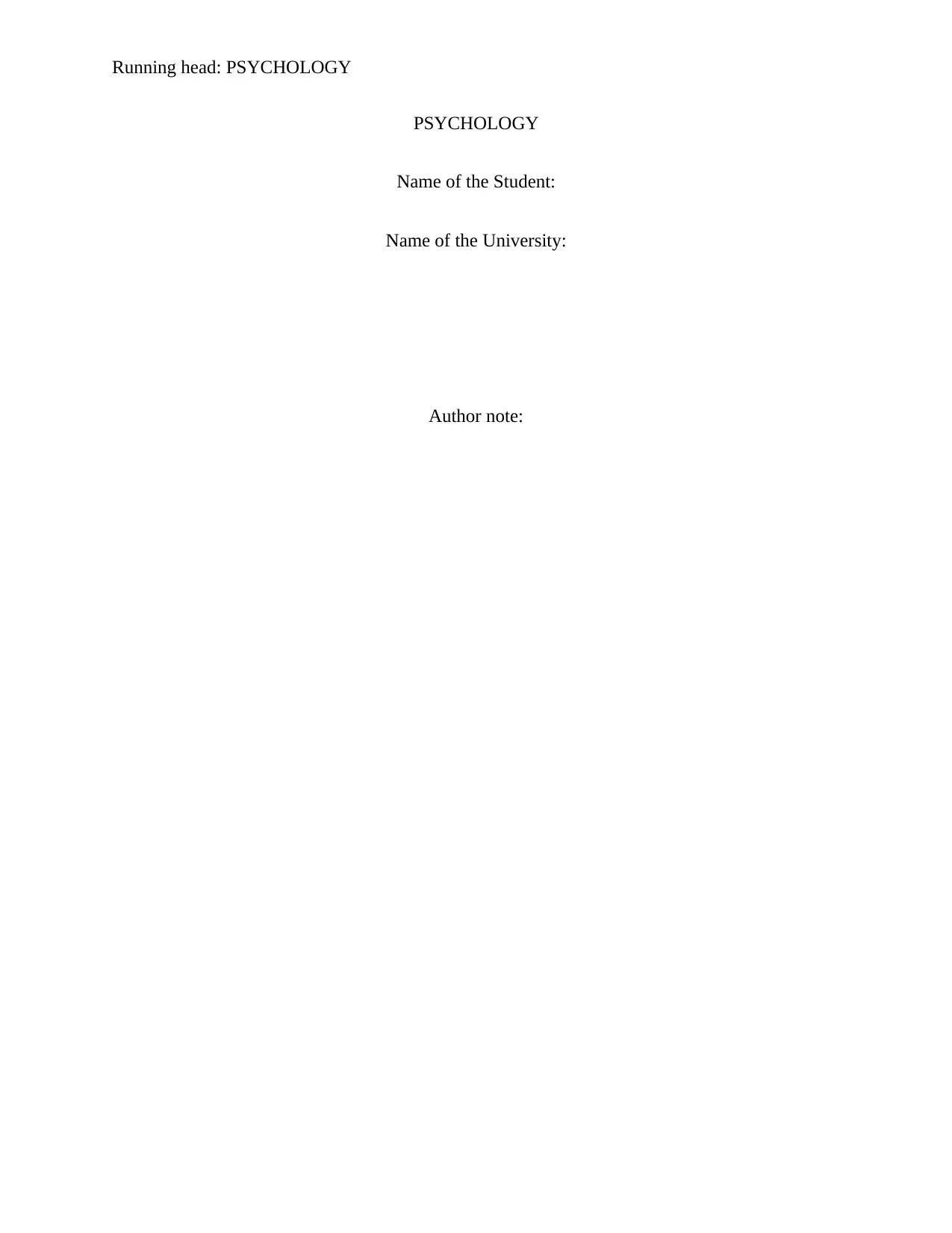
Running head: PSYCHOLOGY
PSYCHOLOGY
Name of the Student:
Name of the University:
Author note:
PSYCHOLOGY
Name of the Student:
Name of the University:
Author note:
Paraphrase This Document
Need a fresh take? Get an instant paraphrase of this document with our AI Paraphraser
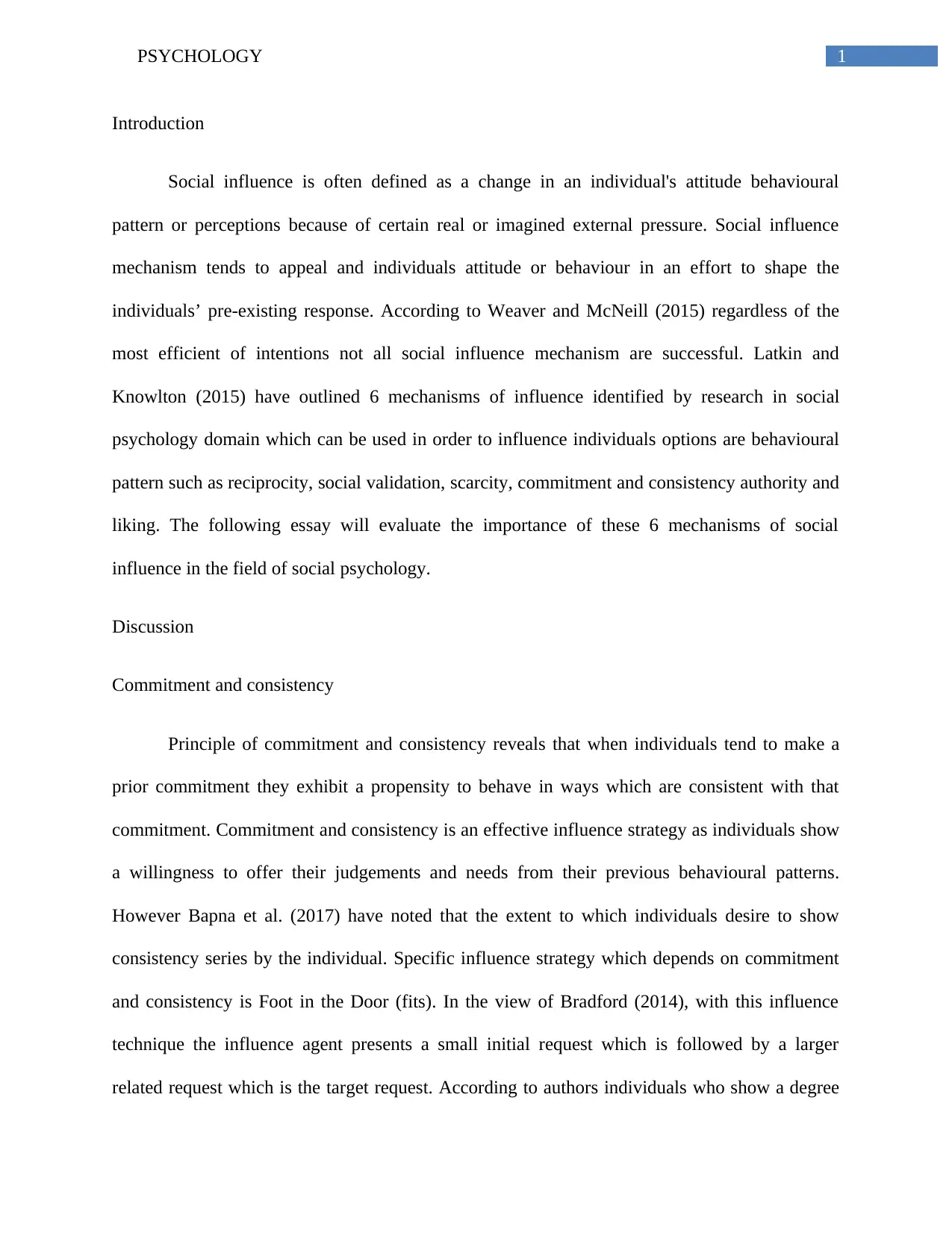
1PSYCHOLOGY
Introduction
Social influence is often defined as a change in an individual's attitude behavioural
pattern or perceptions because of certain real or imagined external pressure. Social influence
mechanism tends to appeal and individuals attitude or behaviour in an effort to shape the
individuals’ pre-existing response. According to Weaver and McNeill (2015) regardless of the
most efficient of intentions not all social influence mechanism are successful. Latkin and
Knowlton (2015) have outlined 6 mechanisms of influence identified by research in social
psychology domain which can be used in order to influence individuals options are behavioural
pattern such as reciprocity, social validation, scarcity, commitment and consistency authority and
liking. The following essay will evaluate the importance of these 6 mechanisms of social
influence in the field of social psychology.
Discussion
Commitment and consistency
Principle of commitment and consistency reveals that when individuals tend to make a
prior commitment they exhibit a propensity to behave in ways which are consistent with that
commitment. Commitment and consistency is an effective influence strategy as individuals show
a willingness to offer their judgements and needs from their previous behavioural patterns.
However Bapna et al. (2017) have noted that the extent to which individuals desire to show
consistency series by the individual. Specific influence strategy which depends on commitment
and consistency is Foot in the Door (fits). In the view of Bradford (2014), with this influence
technique the influence agent presents a small initial request which is followed by a larger
related request which is the target request. According to authors individuals who show a degree
Introduction
Social influence is often defined as a change in an individual's attitude behavioural
pattern or perceptions because of certain real or imagined external pressure. Social influence
mechanism tends to appeal and individuals attitude or behaviour in an effort to shape the
individuals’ pre-existing response. According to Weaver and McNeill (2015) regardless of the
most efficient of intentions not all social influence mechanism are successful. Latkin and
Knowlton (2015) have outlined 6 mechanisms of influence identified by research in social
psychology domain which can be used in order to influence individuals options are behavioural
pattern such as reciprocity, social validation, scarcity, commitment and consistency authority and
liking. The following essay will evaluate the importance of these 6 mechanisms of social
influence in the field of social psychology.
Discussion
Commitment and consistency
Principle of commitment and consistency reveals that when individuals tend to make a
prior commitment they exhibit a propensity to behave in ways which are consistent with that
commitment. Commitment and consistency is an effective influence strategy as individuals show
a willingness to offer their judgements and needs from their previous behavioural patterns.
However Bapna et al. (2017) have noted that the extent to which individuals desire to show
consistency series by the individual. Specific influence strategy which depends on commitment
and consistency is Foot in the Door (fits). In the view of Bradford (2014), with this influence
technique the influence agent presents a small initial request which is followed by a larger
related request which is the target request. According to authors individuals who show a degree
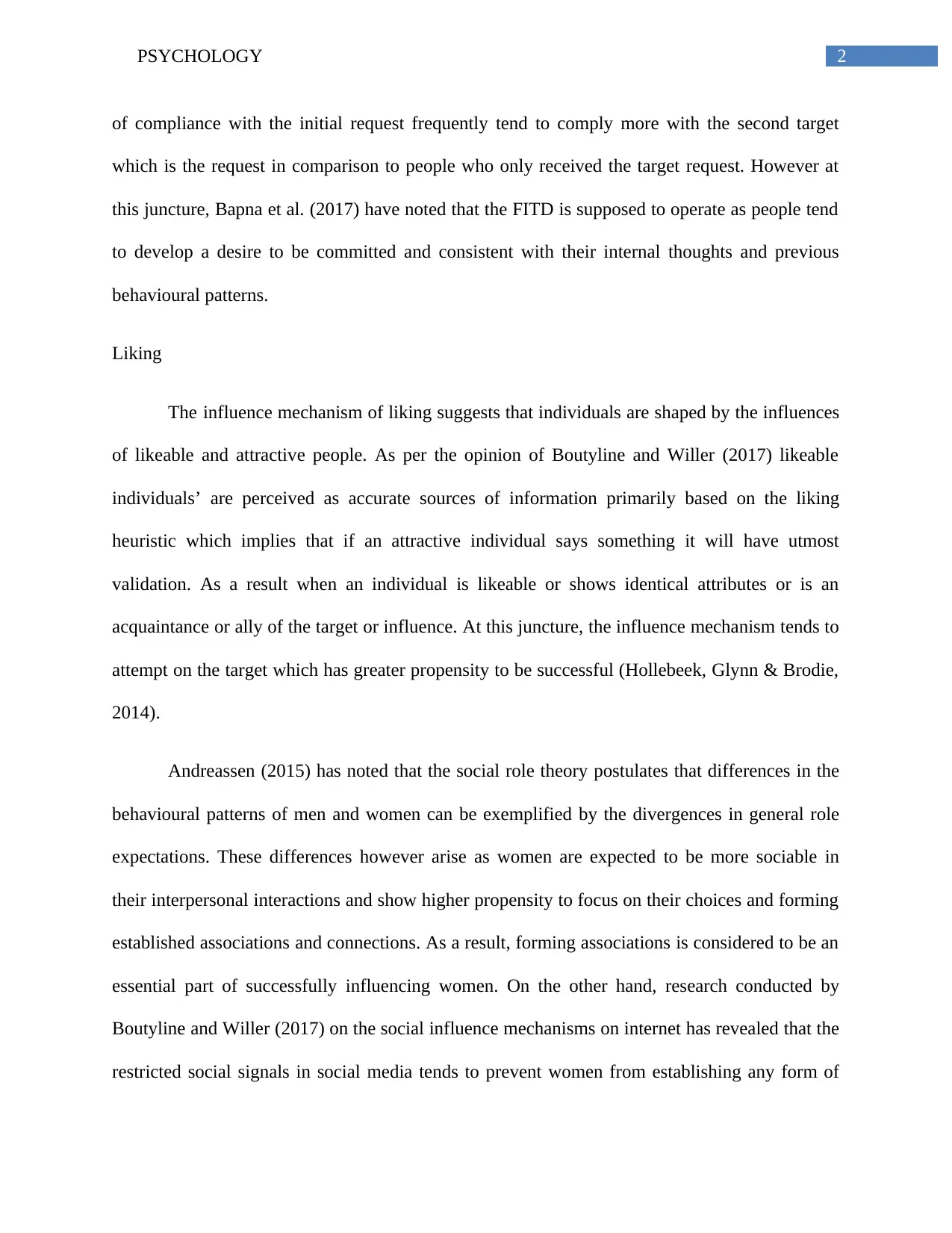
2PSYCHOLOGY
of compliance with the initial request frequently tend to comply more with the second target
which is the request in comparison to people who only received the target request. However at
this juncture, Bapna et al. (2017) have noted that the FITD is supposed to operate as people tend
to develop a desire to be committed and consistent with their internal thoughts and previous
behavioural patterns.
Liking
The influence mechanism of liking suggests that individuals are shaped by the influences
of likeable and attractive people. As per the opinion of Boutyline and Willer (2017) likeable
individuals’ are perceived as accurate sources of information primarily based on the liking
heuristic which implies that if an attractive individual says something it will have utmost
validation. As a result when an individual is likeable or shows identical attributes or is an
acquaintance or ally of the target or influence. At this juncture, the influence mechanism tends to
attempt on the target which has greater propensity to be successful (Hollebeek, Glynn & Brodie,
2014).
Andreassen (2015) has noted that the social role theory postulates that differences in the
behavioural patterns of men and women can be exemplified by the divergences in general role
expectations. These differences however arise as women are expected to be more sociable in
their interpersonal interactions and show higher propensity to focus on their choices and forming
established associations and connections. As a result, forming associations is considered to be an
essential part of successfully influencing women. On the other hand, research conducted by
Boutyline and Willer (2017) on the social influence mechanisms on internet has revealed that the
restricted social signals in social media tends to prevent women from establishing any form of
of compliance with the initial request frequently tend to comply more with the second target
which is the request in comparison to people who only received the target request. However at
this juncture, Bapna et al. (2017) have noted that the FITD is supposed to operate as people tend
to develop a desire to be committed and consistent with their internal thoughts and previous
behavioural patterns.
Liking
The influence mechanism of liking suggests that individuals are shaped by the influences
of likeable and attractive people. As per the opinion of Boutyline and Willer (2017) likeable
individuals’ are perceived as accurate sources of information primarily based on the liking
heuristic which implies that if an attractive individual says something it will have utmost
validation. As a result when an individual is likeable or shows identical attributes or is an
acquaintance or ally of the target or influence. At this juncture, the influence mechanism tends to
attempt on the target which has greater propensity to be successful (Hollebeek, Glynn & Brodie,
2014).
Andreassen (2015) has noted that the social role theory postulates that differences in the
behavioural patterns of men and women can be exemplified by the divergences in general role
expectations. These differences however arise as women are expected to be more sociable in
their interpersonal interactions and show higher propensity to focus on their choices and forming
established associations and connections. As a result, forming associations is considered to be an
essential part of successfully influencing women. On the other hand, research conducted by
Boutyline and Willer (2017) on the social influence mechanisms on internet has revealed that the
restricted social signals in social media tends to prevent women from establishing any form of
⊘ This is a preview!⊘
Do you want full access?
Subscribe today to unlock all pages.

Trusted by 1+ million students worldwide
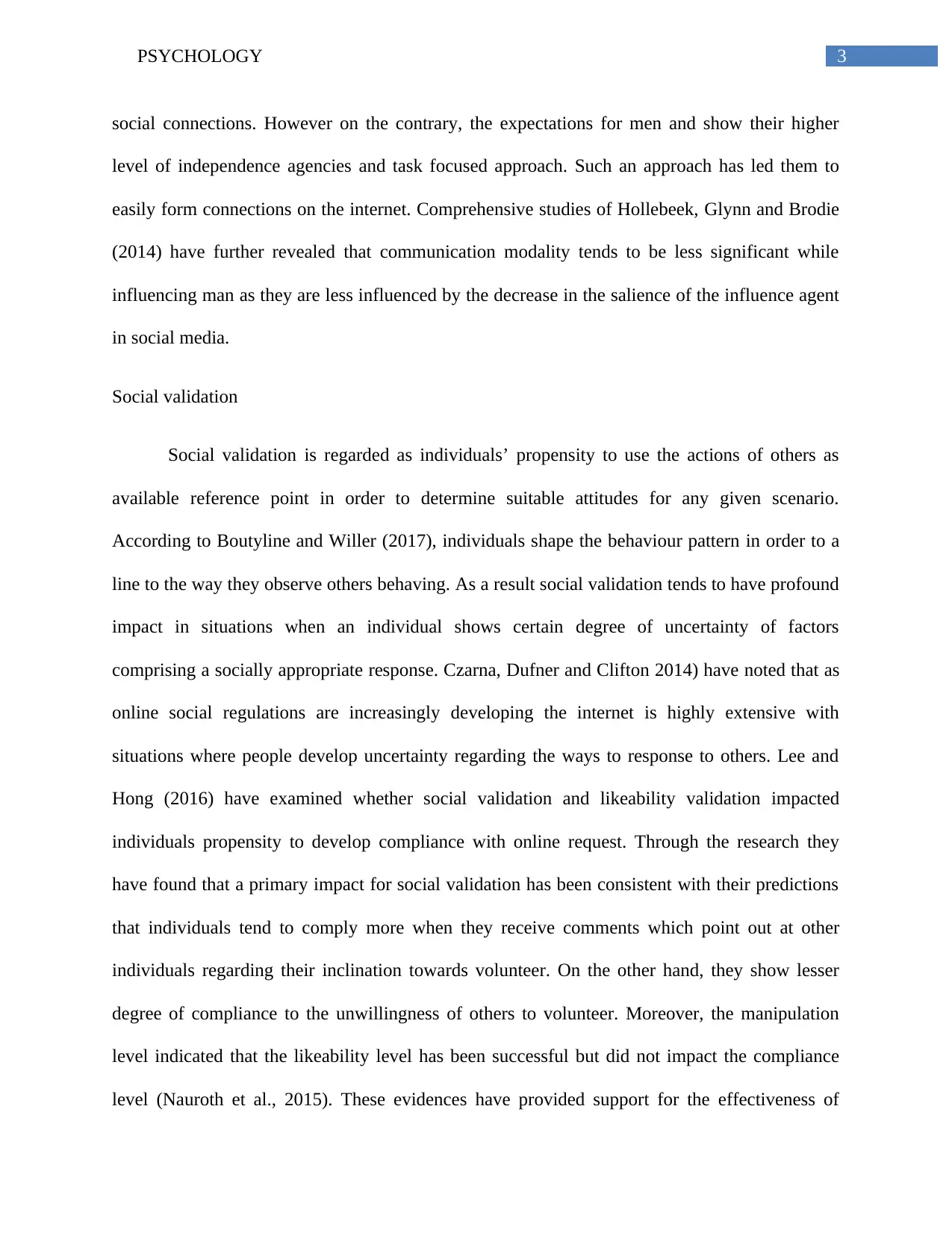
3PSYCHOLOGY
social connections. However on the contrary, the expectations for men and show their higher
level of independence agencies and task focused approach. Such an approach has led them to
easily form connections on the internet. Comprehensive studies of Hollebeek, Glynn and Brodie
(2014) have further revealed that communication modality tends to be less significant while
influencing man as they are less influenced by the decrease in the salience of the influence agent
in social media.
Social validation
Social validation is regarded as individuals’ propensity to use the actions of others as
available reference point in order to determine suitable attitudes for any given scenario.
According to Boutyline and Willer (2017), individuals shape the behaviour pattern in order to a
line to the way they observe others behaving. As a result social validation tends to have profound
impact in situations when an individual shows certain degree of uncertainty of factors
comprising a socially appropriate response. Czarna, Dufner and Clifton 2014) have noted that as
online social regulations are increasingly developing the internet is highly extensive with
situations where people develop uncertainty regarding the ways to response to others. Lee and
Hong (2016) have examined whether social validation and likeability validation impacted
individuals propensity to develop compliance with online request. Through the research they
have found that a primary impact for social validation has been consistent with their predictions
that individuals tend to comply more when they receive comments which point out at other
individuals regarding their inclination towards volunteer. On the other hand, they show lesser
degree of compliance to the unwillingness of others to volunteer. Moreover, the manipulation
level indicated that the likeability level has been successful but did not impact the compliance
level (Nauroth et al., 2015). These evidences have provided support for the effectiveness of
social connections. However on the contrary, the expectations for men and show their higher
level of independence agencies and task focused approach. Such an approach has led them to
easily form connections on the internet. Comprehensive studies of Hollebeek, Glynn and Brodie
(2014) have further revealed that communication modality tends to be less significant while
influencing man as they are less influenced by the decrease in the salience of the influence agent
in social media.
Social validation
Social validation is regarded as individuals’ propensity to use the actions of others as
available reference point in order to determine suitable attitudes for any given scenario.
According to Boutyline and Willer (2017), individuals shape the behaviour pattern in order to a
line to the way they observe others behaving. As a result social validation tends to have profound
impact in situations when an individual shows certain degree of uncertainty of factors
comprising a socially appropriate response. Czarna, Dufner and Clifton 2014) have noted that as
online social regulations are increasingly developing the internet is highly extensive with
situations where people develop uncertainty regarding the ways to response to others. Lee and
Hong (2016) have examined whether social validation and likeability validation impacted
individuals propensity to develop compliance with online request. Through the research they
have found that a primary impact for social validation has been consistent with their predictions
that individuals tend to comply more when they receive comments which point out at other
individuals regarding their inclination towards volunteer. On the other hand, they show lesser
degree of compliance to the unwillingness of others to volunteer. Moreover, the manipulation
level indicated that the likeability level has been successful but did not impact the compliance
level (Nauroth et al., 2015). These evidences have provided support for the effectiveness of
Paraphrase This Document
Need a fresh take? Get an instant paraphrase of this document with our AI Paraphraser
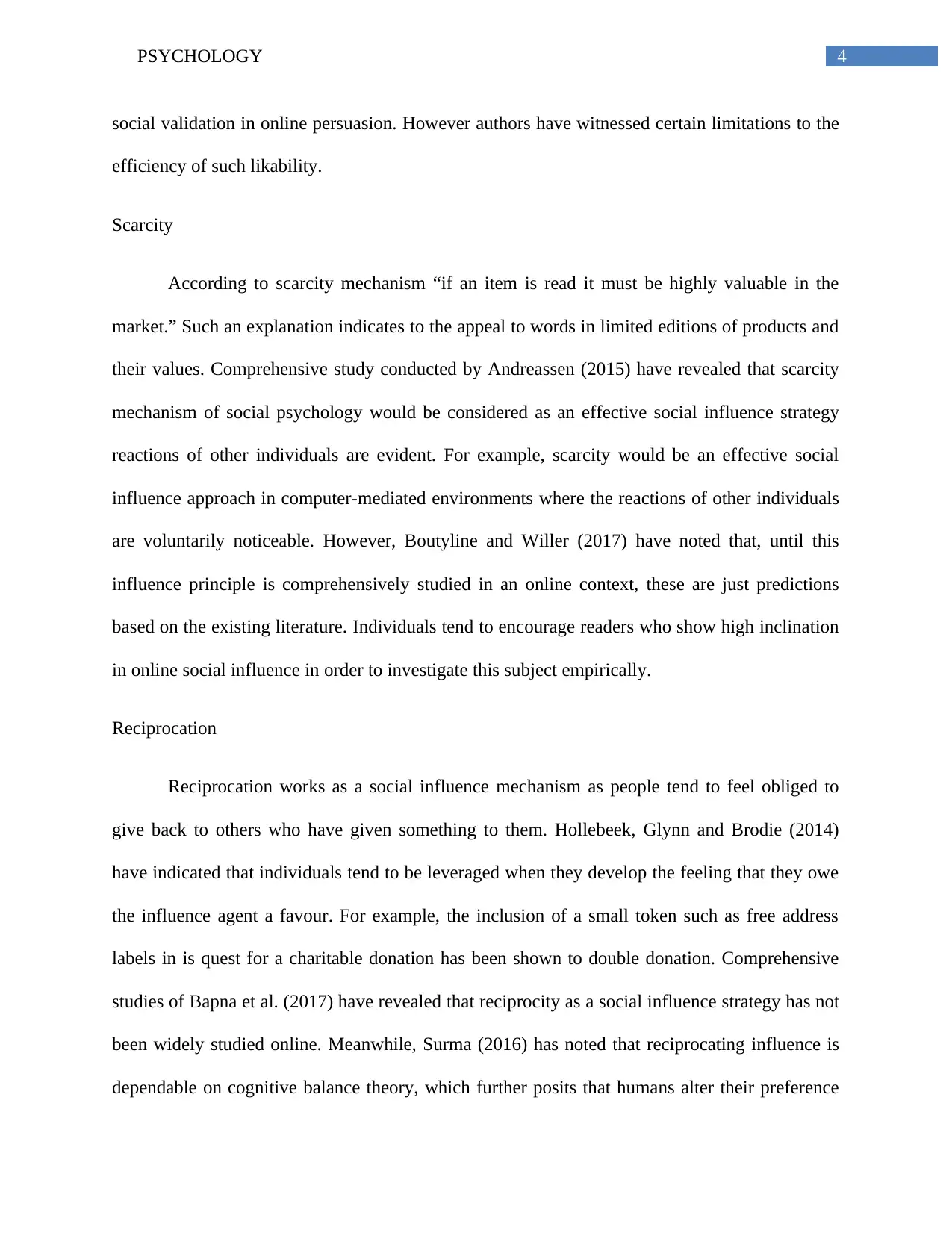
4PSYCHOLOGY
social validation in online persuasion. However authors have witnessed certain limitations to the
efficiency of such likability.
Scarcity
According to scarcity mechanism “if an item is read it must be highly valuable in the
market.” Such an explanation indicates to the appeal to words in limited editions of products and
their values. Comprehensive study conducted by Andreassen (2015) have revealed that scarcity
mechanism of social psychology would be considered as an effective social influence strategy
reactions of other individuals are evident. For example, scarcity would be an effective social
influence approach in computer-mediated environments where the reactions of other individuals
are voluntarily noticeable. However, Boutyline and Willer (2017) have noted that, until this
influence principle is comprehensively studied in an online context, these are just predictions
based on the existing literature. Individuals tend to encourage readers who show high inclination
in online social influence in order to investigate this subject empirically.
Reciprocation
Reciprocation works as a social influence mechanism as people tend to feel obliged to
give back to others who have given something to them. Hollebeek, Glynn and Brodie (2014)
have indicated that individuals tend to be leveraged when they develop the feeling that they owe
the influence agent a favour. For example, the inclusion of a small token such as free address
labels in is quest for a charitable donation has been shown to double donation. Comprehensive
studies of Bapna et al. (2017) have revealed that reciprocity as a social influence strategy has not
been widely studied online. Meanwhile, Surma (2016) has noted that reciprocating influence is
dependable on cognitive balance theory, which further posits that humans alter their preference
social validation in online persuasion. However authors have witnessed certain limitations to the
efficiency of such likability.
Scarcity
According to scarcity mechanism “if an item is read it must be highly valuable in the
market.” Such an explanation indicates to the appeal to words in limited editions of products and
their values. Comprehensive study conducted by Andreassen (2015) have revealed that scarcity
mechanism of social psychology would be considered as an effective social influence strategy
reactions of other individuals are evident. For example, scarcity would be an effective social
influence approach in computer-mediated environments where the reactions of other individuals
are voluntarily noticeable. However, Boutyline and Willer (2017) have noted that, until this
influence principle is comprehensively studied in an online context, these are just predictions
based on the existing literature. Individuals tend to encourage readers who show high inclination
in online social influence in order to investigate this subject empirically.
Reciprocation
Reciprocation works as a social influence mechanism as people tend to feel obliged to
give back to others who have given something to them. Hollebeek, Glynn and Brodie (2014)
have indicated that individuals tend to be leveraged when they develop the feeling that they owe
the influence agent a favour. For example, the inclusion of a small token such as free address
labels in is quest for a charitable donation has been shown to double donation. Comprehensive
studies of Bapna et al. (2017) have revealed that reciprocity as a social influence strategy has not
been widely studied online. Meanwhile, Surma (2016) has noted that reciprocating influence is
dependable on cognitive balance theory, which further posits that humans alter their preference
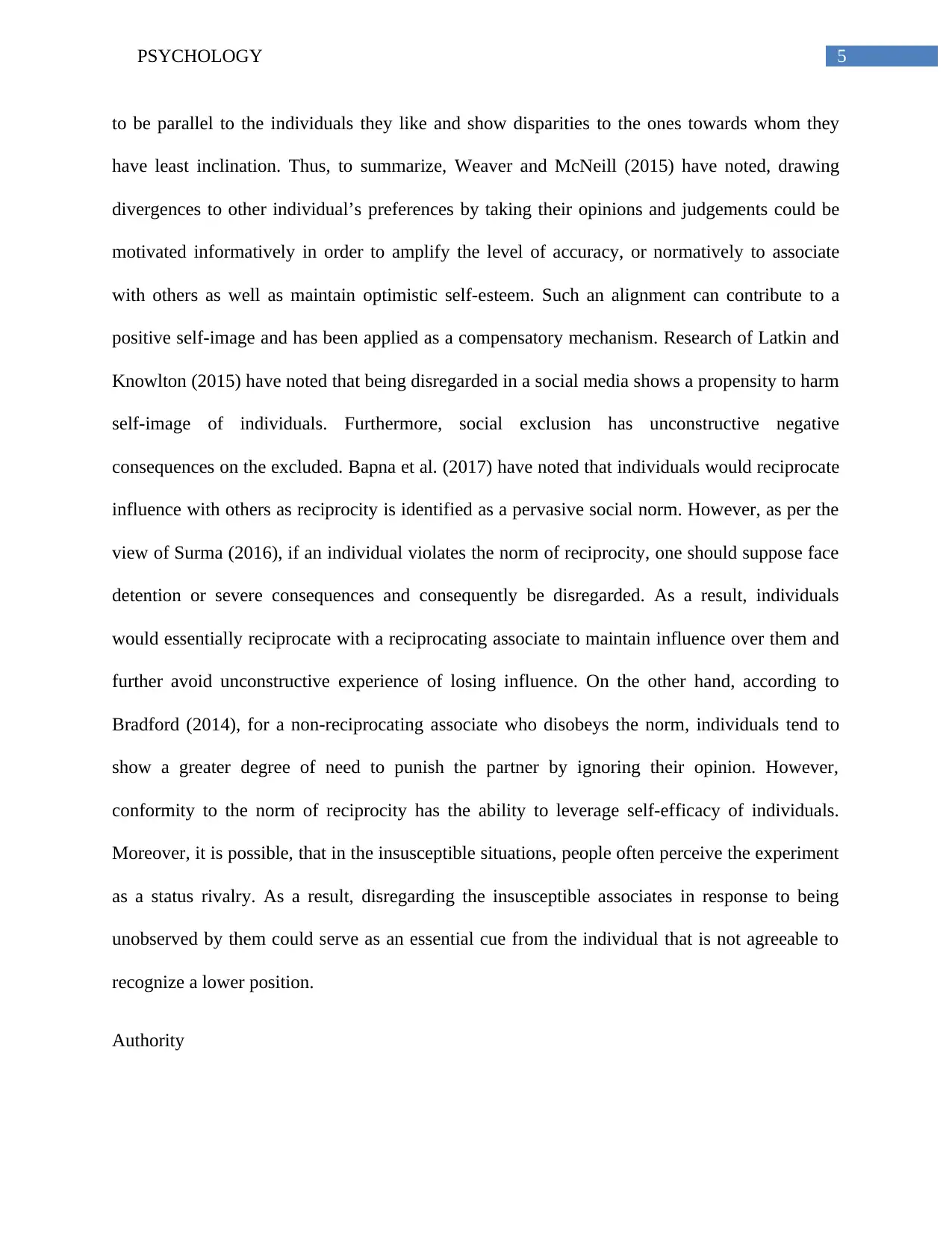
5PSYCHOLOGY
to be parallel to the individuals they like and show disparities to the ones towards whom they
have least inclination. Thus, to summarize, Weaver and McNeill (2015) have noted, drawing
divergences to other individual’s preferences by taking their opinions and judgements could be
motivated informatively in order to amplify the level of accuracy, or normatively to associate
with others as well as maintain optimistic self-esteem. Such an alignment can contribute to a
positive self-image and has been applied as a compensatory mechanism. Research of Latkin and
Knowlton (2015) have noted that being disregarded in a social media shows a propensity to harm
self-image of individuals. Furthermore, social exclusion has unconstructive negative
consequences on the excluded. Bapna et al. (2017) have noted that individuals would reciprocate
influence with others as reciprocity is identified as a pervasive social norm. However, as per the
view of Surma (2016), if an individual violates the norm of reciprocity, one should suppose face
detention or severe consequences and consequently be disregarded. As a result, individuals
would essentially reciprocate with a reciprocating associate to maintain influence over them and
further avoid unconstructive experience of losing influence. On the other hand, according to
Bradford (2014), for a non-reciprocating associate who disobeys the norm, individuals tend to
show a greater degree of need to punish the partner by ignoring their opinion. However,
conformity to the norm of reciprocity has the ability to leverage self-efficacy of individuals.
Moreover, it is possible, that in the insusceptible situations, people often perceive the experiment
as a status rivalry. As a result, disregarding the insusceptible associates in response to being
unobserved by them could serve as an essential cue from the individual that is not agreeable to
recognize a lower position.
Authority
to be parallel to the individuals they like and show disparities to the ones towards whom they
have least inclination. Thus, to summarize, Weaver and McNeill (2015) have noted, drawing
divergences to other individual’s preferences by taking their opinions and judgements could be
motivated informatively in order to amplify the level of accuracy, or normatively to associate
with others as well as maintain optimistic self-esteem. Such an alignment can contribute to a
positive self-image and has been applied as a compensatory mechanism. Research of Latkin and
Knowlton (2015) have noted that being disregarded in a social media shows a propensity to harm
self-image of individuals. Furthermore, social exclusion has unconstructive negative
consequences on the excluded. Bapna et al. (2017) have noted that individuals would reciprocate
influence with others as reciprocity is identified as a pervasive social norm. However, as per the
view of Surma (2016), if an individual violates the norm of reciprocity, one should suppose face
detention or severe consequences and consequently be disregarded. As a result, individuals
would essentially reciprocate with a reciprocating associate to maintain influence over them and
further avoid unconstructive experience of losing influence. On the other hand, according to
Bradford (2014), for a non-reciprocating associate who disobeys the norm, individuals tend to
show a greater degree of need to punish the partner by ignoring their opinion. However,
conformity to the norm of reciprocity has the ability to leverage self-efficacy of individuals.
Moreover, it is possible, that in the insusceptible situations, people often perceive the experiment
as a status rivalry. As a result, disregarding the insusceptible associates in response to being
unobserved by them could serve as an essential cue from the individual that is not agreeable to
recognize a lower position.
Authority
⊘ This is a preview!⊘
Do you want full access?
Subscribe today to unlock all pages.

Trusted by 1+ million students worldwide

6PSYCHOLOGY
Authority serves as an influence approach as authority figures are perceived as experts.
Boutyline and Willer (2017) have predicted that the authority figure would be highly decisive.
However, such an influence would be attenuated amongst the out-group as well as accentuated
amongst the in-group, because individuals generally prefer individuals from their own in-group.
Hollebeek, Glynn and Brodie (2014) have noted that gender and in-group or out-group position
also leverage whether authority tends to be an attainable influence approach.
Conclusion
Hence to conclude, social influence mechanisms primarily operate in the domain of
social psychology in a way that draws relevance to its function in face-to-face interactions. It has
been noted that when an individual principle shows certain level of autonomy on the salience of
the social influence agent such as commitment and consistency, the vital form of communication
approach is not significant as the decision to fulfil or obey is formed when an individual
evaluates his or her own previous behavioural patterns.
Authority serves as an influence approach as authority figures are perceived as experts.
Boutyline and Willer (2017) have predicted that the authority figure would be highly decisive.
However, such an influence would be attenuated amongst the out-group as well as accentuated
amongst the in-group, because individuals generally prefer individuals from their own in-group.
Hollebeek, Glynn and Brodie (2014) have noted that gender and in-group or out-group position
also leverage whether authority tends to be an attainable influence approach.
Conclusion
Hence to conclude, social influence mechanisms primarily operate in the domain of
social psychology in a way that draws relevance to its function in face-to-face interactions. It has
been noted that when an individual principle shows certain level of autonomy on the salience of
the social influence agent such as commitment and consistency, the vital form of communication
approach is not significant as the decision to fulfil or obey is formed when an individual
evaluates his or her own previous behavioural patterns.
Paraphrase This Document
Need a fresh take? Get an instant paraphrase of this document with our AI Paraphraser
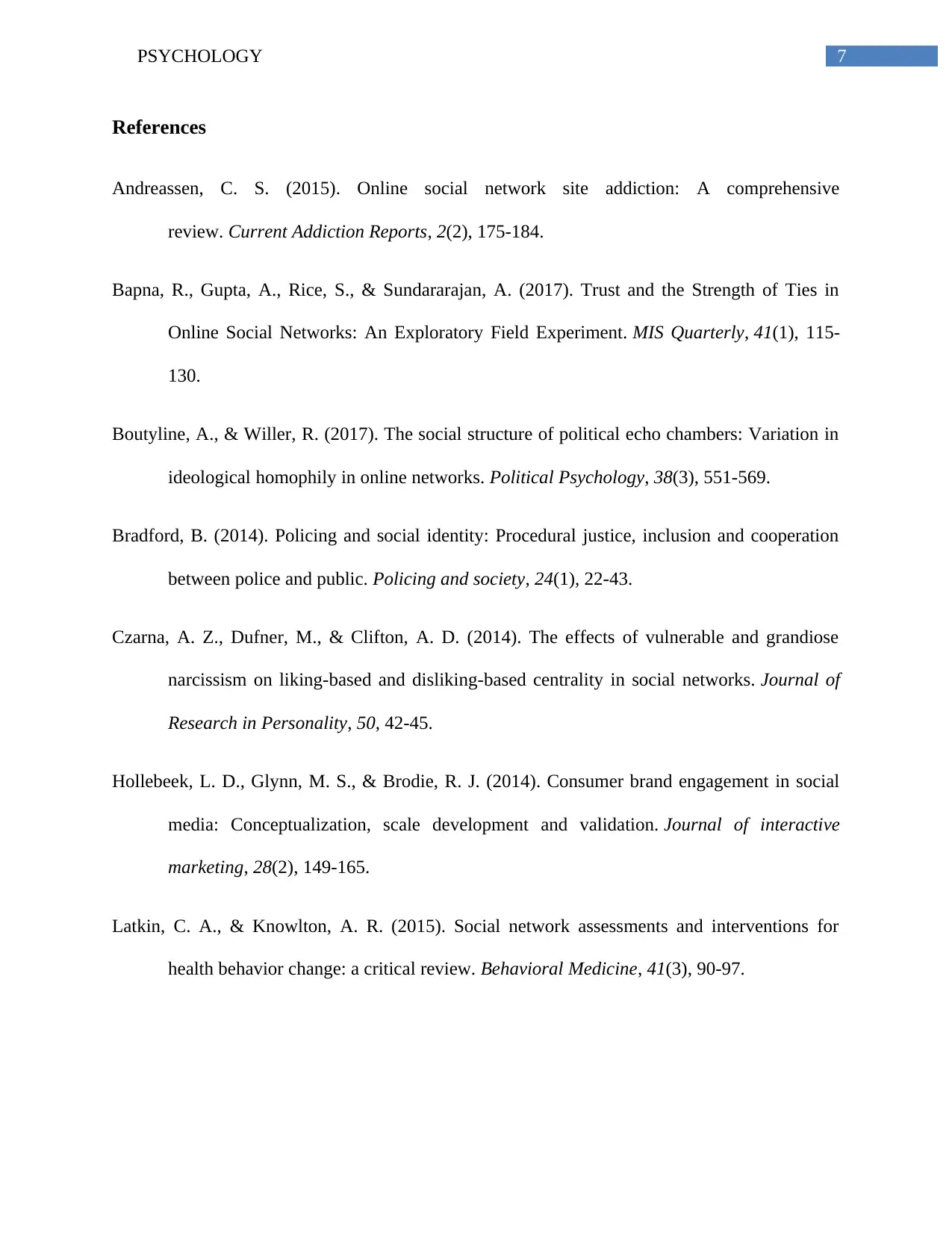
7PSYCHOLOGY
References
Andreassen, C. S. (2015). Online social network site addiction: A comprehensive
review. Current Addiction Reports, 2(2), 175-184.
Bapna, R., Gupta, A., Rice, S., & Sundararajan, A. (2017). Trust and the Strength of Ties in
Online Social Networks: An Exploratory Field Experiment. MIS Quarterly, 41(1), 115-
130.
Boutyline, A., & Willer, R. (2017). The social structure of political echo chambers: Variation in
ideological homophily in online networks. Political Psychology, 38(3), 551-569.
Bradford, B. (2014). Policing and social identity: Procedural justice, inclusion and cooperation
between police and public. Policing and society, 24(1), 22-43.
Czarna, A. Z., Dufner, M., & Clifton, A. D. (2014). The effects of vulnerable and grandiose
narcissism on liking-based and disliking-based centrality in social networks. Journal of
Research in Personality, 50, 42-45.
Hollebeek, L. D., Glynn, M. S., & Brodie, R. J. (2014). Consumer brand engagement in social
media: Conceptualization, scale development and validation. Journal of interactive
marketing, 28(2), 149-165.
Latkin, C. A., & Knowlton, A. R. (2015). Social network assessments and interventions for
health behavior change: a critical review. Behavioral Medicine, 41(3), 90-97.
References
Andreassen, C. S. (2015). Online social network site addiction: A comprehensive
review. Current Addiction Reports, 2(2), 175-184.
Bapna, R., Gupta, A., Rice, S., & Sundararajan, A. (2017). Trust and the Strength of Ties in
Online Social Networks: An Exploratory Field Experiment. MIS Quarterly, 41(1), 115-
130.
Boutyline, A., & Willer, R. (2017). The social structure of political echo chambers: Variation in
ideological homophily in online networks. Political Psychology, 38(3), 551-569.
Bradford, B. (2014). Policing and social identity: Procedural justice, inclusion and cooperation
between police and public. Policing and society, 24(1), 22-43.
Czarna, A. Z., Dufner, M., & Clifton, A. D. (2014). The effects of vulnerable and grandiose
narcissism on liking-based and disliking-based centrality in social networks. Journal of
Research in Personality, 50, 42-45.
Hollebeek, L. D., Glynn, M. S., & Brodie, R. J. (2014). Consumer brand engagement in social
media: Conceptualization, scale development and validation. Journal of interactive
marketing, 28(2), 149-165.
Latkin, C. A., & Knowlton, A. R. (2015). Social network assessments and interventions for
health behavior change: a critical review. Behavioral Medicine, 41(3), 90-97.

8PSYCHOLOGY
Lee, J., & Hong, I. B. (2016). Predicting positive user responses to social media advertising: The
roles of emotional appeal, informativeness, and creativity. International Journal of
Information Management, 36(3), 360-373.
Nauroth, P., Gollwitzer, M., Bender, J., & Rothmund, T. (2015). Social identity threat motivates
science-discrediting online comments. PLoS one, 10(2), e0117476.
Rost, K., Stahel, L., & Frey, B. S. (2016). Digital social norm enforcement: Online firestorms in
social media. PLoS one, 11(6), e0155923.
Surma, J. (2016). Social exchange in online social networks. The reciprocity phenomenon on
Facebook. Computer Communications, 73, 342-346.
Weaver, B., & McNeill, F. (2015). Lifelines: Desistance, social relations, and
reciprocity. Criminal justice and behavior, 42(1), 95-107.
Lee, J., & Hong, I. B. (2016). Predicting positive user responses to social media advertising: The
roles of emotional appeal, informativeness, and creativity. International Journal of
Information Management, 36(3), 360-373.
Nauroth, P., Gollwitzer, M., Bender, J., & Rothmund, T. (2015). Social identity threat motivates
science-discrediting online comments. PLoS one, 10(2), e0117476.
Rost, K., Stahel, L., & Frey, B. S. (2016). Digital social norm enforcement: Online firestorms in
social media. PLoS one, 11(6), e0155923.
Surma, J. (2016). Social exchange in online social networks. The reciprocity phenomenon on
Facebook. Computer Communications, 73, 342-346.
Weaver, B., & McNeill, F. (2015). Lifelines: Desistance, social relations, and
reciprocity. Criminal justice and behavior, 42(1), 95-107.
⊘ This is a preview!⊘
Do you want full access?
Subscribe today to unlock all pages.

Trusted by 1+ million students worldwide
1 out of 9
Related Documents
Your All-in-One AI-Powered Toolkit for Academic Success.
+13062052269
info@desklib.com
Available 24*7 on WhatsApp / Email
![[object Object]](/_next/static/media/star-bottom.7253800d.svg)
Unlock your academic potential
Copyright © 2020–2025 A2Z Services. All Rights Reserved. Developed and managed by ZUCOL.




